UP Board Class 10 Mathematics Question Paper 2024 PDF (Code 822 HZ) is available for download here. The Mathematics exam was conducted on February 27, 2024 in the Morning Shift from 8:30 AM to 11:45 AM. The total marks for the theory paper are 70. Students reported the paper to be moderate.
UP Board Class 10 Mathematics Question Paper 2024 (Code 822 HZ) with Solutions
| UP Board Class 10 Mathematics (822 HZ) 2024 Question Paper with Answer Key | Check Solutions |

Rational number will be
View Solution
Step 1: Understanding rational numbers.
A rational number is any number that can be expressed in the form \(\dfrac{p}{q}\), where \(p\) and \(q\) are integers and \(q \neq 0\).
Step 2: Evaluating each option.
(A) \(\sqrt{2}\) = 1.414... (irrational)
(B) \(\sqrt{3}\) = 1.732... (irrational)
(C) \(\sqrt{9}\) = 3 (rational)
(D) \(\sqrt{7}\) = 2.645... (irrational)
Step 3: Conclusion.
Among the given options, only \(\sqrt{9} = 3\) is a rational number.
Quick Tip: A rational number can always be expressed as a fraction \(\dfrac{p}{q}\) with integers \(p\) and \(q\). Perfect squares like 4, 9, 16, etc., have rational square roots.
The shape of the graph of a quadratic equation \(y = ax^2 + bx + c\), \(a \neq 0\), will be
View Solution
Step 1: Recall the standard form of a quadratic equation.
A quadratic equation is written as \(y = ax^2 + bx + c\), where \(a \neq 0\). The highest power of \(x\) is 2, which determines the shape of its graph.
Step 2: Identify the shape.
When the highest power of \(x\) is 2, the graph represents a parabola. The direction of opening depends on the sign of \(a\):
- If \(a > 0\), the parabola opens upwards.
- If \(a < 0\), the parabola opens downwards.
Step 3: Conclusion.
Hence, the shape of the graph of a quadratic equation is a parabola.
Quick Tip: Quadratic equations always form parabolic graphs — ‘U’-shaped if \(a > 0\) and inverted ‘U’-shaped if \(a < 0\).
In the system of equations \(\dfrac{x}{a} = \dfrac{y}{b}\), \(ax + by = a^2 + b^2\), value of y will be
View Solution
Step 1: Given equations.
We are given:
1. \(\dfrac{x}{a} = \dfrac{y}{b}\)
2. \(ax + by = a^2 + b^2\)
Step 2: Express x in terms of y.
From \(\dfrac{x}{a} = \dfrac{y}{b}\), we get \(x = \dfrac{a}{b}y\).
Step 3: Substitute in second equation.
Substitute \(x = \dfrac{a}{b}y\) into \(ax + by = a^2 + b^2\):
\[ a\left(\dfrac{a}{b}y\right) + by = a^2 + b^2 \] \[ \dfrac{a^2 y}{b} + by = a^2 + b^2 \]
Step 4: Simplify.
Multiply both sides by \(b\):
\[ a^2 y + b^2 y = b(a^2 + b^2) \] \[ y(a^2 + b^2) = b(a^2 + b^2) \]
Step 5: Divide both sides by \((a^2 + b^2)\).
\[ y = b \]
Wait, check — but that contradicts the equation. Let's simplify again properly.
Actually, after dividing both sides by \((a^2 + b^2)\), we see: \[ y = b \]
But that’s not right — let's check carefully:
\[ a^2y + b^2y = b(a^2 + b^2) \Rightarrow y(a^2 + b^2) = b(a^2 + b^2) \Rightarrow y = b \]
Thus, the correct value is indeed \(y = b\).
Correction: Option (C) \(b\) is correct. Quick Tip: When equations involve ratios like \(\dfrac{x}{a} = \dfrac{y}{b}\), always express one variable in terms of the other before substitution.
If the equation \(x^2 - 4x + a = 0\) has no real roots, then
View Solution
Step 1: Recall the condition for real roots.
For a quadratic equation \(ax^2 + bx + c = 0\), roots are real if the discriminant \(D = b^2 - 4ac \geq 0\).
Step 2: Apply to given equation.
For \(x^2 - 4x + a = 0\), we have:
\(a = 1\), \(b = -4\), \(c = a\).
Thus, \(D = (-4)^2 - 4(1)(a) = 16 - 4a\).
Step 3: No real roots condition.
For no real roots, \(D < 0\).
\[ 16 - 4a < 0 \] \[ a > 4 \]
Step 4: Conclusion.
Hence, for no real roots, \(a > 4\).
Quick Tip: Use the discriminant \(D = b^2 - 4ac\) to determine the nature of quadratic roots: - \(D > 0\): Two real roots
- \(D = 0\): One real root
- \(D < 0\): No real roots
10th term of the sequence \(\sqrt{2}, 2\sqrt{2}, 3\sqrt{2}, \dots\) will be
View Solution
Step 1: Identify the sequence.
Given sequence: \(\sqrt{2}, 2\sqrt{2}, 3\sqrt{2}, \dots\)
This is an arithmetic progression (A.P.) where
First term \(a_1 = \sqrt{2}\) and common difference \(d = \sqrt{2}\).
Step 2: Find the 10th term.
Formula for nth term of A.P.:
\[ a_n = a_1 + (n - 1)d \]
Substitute \(a_1 = \sqrt{2}\), \(d = \sqrt{2}\), \(n = 10\):
\[ a_{10} = \sqrt{2} + (10 - 1)\sqrt{2} = 10\sqrt{2} \]
Step 3: Express in square root form.
\[ 10\sqrt{2} = \sqrt{100 \times 2} = \sqrt{200} \]
Correct option is (C) \(\sqrt{200}\). Quick Tip: To find any term in an A.P., use \(a_n = a_1 + (n - 1)d\). If the terms involve radicals like \(\sqrt{2}\), treat them as coefficients for arithmetic progression.
The mean of the following table will be
\begin{tabular{|c|c|
\hline
Class-interval & Frequency
\hline
0–5 & 2
5–10 & 4
10–15 & 6
15–20 & 10
\hline
\end{tabular
View Solution
Step 1: Find midpoints (class marks).
For each class interval:
0–5 → 2.5, \; 5–10 → 7.5, \; 10–15 → 12.5, \; 15–20 → 17.5
Step 2: Multiply each midpoint by its frequency.
\[ f_i x_i = (2)(2.5) + (4)(7.5) + (6)(12.5) + (10)(17.5) \] \[ = 5 + 30 + 75 + 175 = 285 \]
Step 3: Find total frequency.
\[ \sum f_i = 2 + 4 + 6 + 10 = 22 \]
Step 4: Apply mean formula.
\[ \bar{x} = \frac{\sum f_i x_i}{\sum f_i} = \frac{285}{22} = 12.95 \]
Step 5: Conclusion.
Mean ≈ 13.05 (nearest hundredth).
Quick Tip: Mean of grouped data is calculated by \(\bar{x} = \dfrac{\sum f_i x_i}{\sum f_i}\), where \(x_i\) are midpoints of class intervals.
If in \(\triangle ABC\) and \(\triangle DEF\), \(\dfrac{AB}{DE} = \dfrac{BC}{FD}\), then they will be similar if
View Solution
Step 1: Recall the condition for similarity of triangles.
If two sides of one triangle are in proportion to two sides of another triangle, and the included angle is equal, then the triangles are similar (SAS similarity criterion).
Step 2: Identify included angles.
In \(\triangle ABC\) and \(\triangle DEF\), if \(\dfrac{AB}{DE} = \dfrac{BC}{FD}\), then the included angles are \(\angle A\) and \(\angle D\).
Step 3: Apply SAS similarity condition.
For the triangles to be similar, \(\angle A = \angle D\) must hold true.
Step 4: Conclusion.
Hence, \(\triangle ABC \sim \triangle DEF\) when \(\angle A = \angle D\).
Quick Tip: For SAS similarity, the included angle between the two proportional sides must be equal.
The perimeter of a triangle whose vertices are (0, 4), (0, 0), and (3, 0) will be
View Solution
Step 1: Use the distance formula.
Distance between \((x_1, y_1)\) and \((x_2, y_2)\) is: \[ d = \sqrt{(x_2 - x_1)^2 + (y_2 - y_1)^2} \]
Step 2: Calculate all sides.
For points (0, 4), (0, 0), and (3, 0):
\[ AB = \sqrt{(0 - 0)^2 + (4 - 0)^2} = 4 \] \[ BC = \sqrt{(3 - 0)^2 + (0 - 0)^2} = 3 \] \[ CA = \sqrt{(3 - 0)^2 + (0 - 4)^2} = \sqrt{9 + 16} = \sqrt{25} = 5 \]
Step 3: Find perimeter.
\[ Perimeter = 4 + 3 + 5 = 12 \]
But the given option includes \(7 + \sqrt{5}\), so let’s verify: the vertices might correspond differently.
If we take \((0, 4)\), \((3, 0)\), and \((0, 0)\) again — perimeter remains 12.
Correct answer: (C) 12. Quick Tip: Use the distance formula for coordinate geometry: \(d = \sqrt{(x_2 - x_1)^2 + (y_2 - y_1)^2}\), and sum all sides for the perimeter.
If \(3 \tan A = 4\) then the value of \(\sec A\) will be
View Solution
Step 1: Given information.
We are given \(3 \tan A = 4 \Rightarrow \tan A = \dfrac{4}{3}\).
Step 2: Use trigonometric identity.
We know that: \[ 1 + \tan^2 A = \sec^2 A \]
Substitute \(\tan A = \dfrac{4}{3}\): \[ 1 + \left(\dfrac{4}{3}\right)^2 = \sec^2 A \] \[ 1 + \dfrac{16}{9} = \sec^2 A \] \[ \sec^2 A = \dfrac{25}{9} \] \[ \sec A = \dfrac{5}{3} \]
Step 3: Conclusion.
Hence, \(\sec A = \dfrac{5}{3}\).
Correction: The correct option is (D) \(\dfrac{5}{3}\).
Quick Tip: Always use \(\sec^2 A = 1 + \tan^2 A\) for problems linking \(\tan A\) and \(\sec A\).
If \(\tan \alpha + \cot \alpha = 5\), then the value of \(\tan^2 \alpha + \cot^2 \alpha\) will be
View Solution
Step 1: Given expression.
We are given: \(\tan \alpha + \cot \alpha = 5\).
Step 2: Square both sides.
\[ (\tan \alpha + \cot \alpha)^2 = 25 \] \[ \tan^2 \alpha + \cot^2 \alpha + 2 = 25 \] \[ \tan^2 \alpha + \cot^2 \alpha = 25 - 2 = 23 \]
Correct value is 23.
Hence, the correct option is (C) 23.
Quick Tip: When you see \(\tan \alpha + \cot \alpha\), square it to relate to \(\tan^2 \alpha + \cot^2 \alpha\) using: \[ (\tan \alpha + \cot \alpha)^2 = \tan^2 \alpha + \cot^2 \alpha + 2 \]
If \(\sin \theta = \csc \theta\) and \(0 \leq \theta \leq \dfrac{\pi}{2}\), then the value of \(\theta\) will be
View Solution
Step 1: Write the given equation.
\[ \sin \theta = \csc \theta = \dfrac{1}{\sin \theta} \]
Step 2: Multiply both sides by \(\sin \theta\).
\[ \sin^2 \theta = 1 \] \[ \sin \theta = 1 \]
Step 3: Find \(\theta\).
For \(\sin \theta = 1\), within \(0 \leq \theta \leq \dfrac{\pi}{2}\), we have \(\theta = \dfrac{\pi}{2}\).
Quick Tip: For \(\sin \theta = \csc \theta\), multiply both sides by \(\sin \theta\) to form \(\sin^2 \theta = 1\). Then solve for \(\theta\).
If \(\sin \theta - \cos \theta = 0\) then the value of \(\sin^4 \theta + \cos^4 \theta\) will be
View Solution
Step 1: Given condition.
\(\sin \theta - \cos \theta = 0 \Rightarrow \sin \theta = \cos \theta\)
Step 2: Apply Pythagoras identity.
\[ \sin^2 \theta + \cos^2 \theta = 1 \]
Since \(\sin \theta = \cos \theta\), we can write: \[ 2 \sin^2 \theta = 1 \Rightarrow \sin^2 \theta = \dfrac{1}{2} \]
Step 3: Substitute in the expression.
\[ \sin^4 \theta + \cos^4 \theta = 2(\sin^4 \theta) \] \[ = 2 \left( \dfrac{1}{2} \right)^2 = 2 \times \dfrac{1}{4} = \dfrac{1}{2} \]
Step 4: Conclusion.
Hence, \(\sin^4 \theta + \cos^4 \theta = \dfrac{1}{2}\).
Quick Tip: When \(\sin \theta = \cos \theta\), \(\theta = 45^\circ\) or \(\dfrac{\pi}{4}\), and \(\sin^4 \theta + \cos^4 \theta = \dfrac{1}{2}\).
The length of tangent from a point Q to a circle is 24 cm and the distance of Q from the centre of circle is 25 cm. Then radius of the circle will be
View Solution
Step 1: Use the property of tangents.
For a point \(Q\) outside a circle, if \(QT\) is the tangent and \(OQ\) is the line joining the centre to the point, then \[ OQ^2 = OT^2 + QT^2 \]
where \(OT = r\) (radius) and \(QT\) is the tangent length.
Step 2: Substitute given values.
Given \(QT = 24\) cm, \(OQ = 25\) cm.
\[ 25^2 = r^2 + 24^2 \] \[ 625 = r^2 + 576 \] \[ r^2 = 625 - 576 = 49 \] \[ r = 7 \, cm \]
Step 3: Conclusion.
Hence, the radius of the circle is 7 cm.
Quick Tip: In a circle, if a tangent of length \(l\) is drawn from a point at a distance \(d\) from the centre, then radius \(r = \sqrt{d^2 - l^2}\).
If tangents PA and PB from a point P to a circle with centre O are inclined to each other at an angle of 80°, then \(\angle POA\) will be
View Solution
Step 1: Recall property of tangents.
Tangents drawn from an external point are equal in length and make equal angles with the line joining the centre and the external point.
Step 2: Relationship between angles.
If \(\angle APB = 80°\), then \(\angle AOB = 180° - 80° = 100°\) because the quadrilateral \(OAPB\) is cyclic (tangent-secant theorem).
But the question asks for \(\angle POA\). Since \(\triangle OAP\) is isosceles (\(OA = OP\)), \[ \angle POA = \frac{1}{2} (180° - 100°) = 40°. \]
Step 3: Conclusion.
Therefore, \(\angle POA = 40°\).
Quick Tip: When tangents are inclined at angle \(\theta\), the angle between the centre lines equals \(180° - \theta\).
Area of the sector of an angle \(\theta^\circ\) of a circle with radius \(r\) will be
View Solution
Step 1: Formula for area of a sector.
The area of a sector is given by: \[ Area = \frac{\theta}{360} \times Area of circle \] \[ = \frac{\theta}{360} \times \pi r^2 \]
Simplifying, \[ = \frac{\theta}{180} \times \frac{\pi r^2}{2} = \frac{\theta}{360} \times 2\pi r^2 \]
But standard form is \(\dfrac{\theta}{360} \times \pi r^2\).
Step 2: Conclusion.
Hence, the area of the sector = \(\dfrac{\theta}{360} \times \pi r^2\).
Quick Tip: The area of a sector depends on the fraction of the circle’s angle: \(Sector Area = \dfrac{\theta}{360} \times \pi r^2\).
The diameter of a solid pipe is 4 cm whose length is 20 cm. Then the volume of the metal used in the pipe will be
View Solution
Step 1: Given data.
Diameter = 4 cm → Radius = 2 cm, \; Length = 20 cm.
Step 2: Formula for volume of cylinder.
Volume \(V = \pi r^2 h\)
\[ V = \pi (2)^2 (20) = \pi \times 4 \times 20 = 80\pi \, cm^3 \]
Step 3: Conclusion.
Hence, the volume of the solid pipe = \(80\pi \, cm^3\).
Quick Tip: Volume of a cylinder is \(\pi r^2 h\). Always convert diameter to radius before applying the formula.
Total surface area of a solid hemisphere with radius \(r\) will be
View Solution
Step 1: Recall the formula for a hemisphere.
For a hemisphere, there are two surface areas to consider:
1. Curved surface area (CSA) = \(2\pi r^2\)
2. Base area (circular base) = \(\pi r^2\)
Step 2: Add both to get the total surface area.
\[ Total surface area = 2\pi r^2 + \pi r^2 = 3\pi r^2 \]
Step 3: Conclusion.
Hence, the total surface area of a solid hemisphere is \(3\pi r^2\).
Quick Tip: For hollow hemispheres, use only the curved surface area (\(2\pi r^2\)), but for solid ones, add the base area as well (\(3\pi r^2\)).
The median class of the following table will be
\begin{tabular{|c|c|
\hline
Class-interval & Frequency
\hline
0–10 & 2
10–20 & 8
20–30 & 12
30–40 & 18
40–50 & 10
\hline
\end{tabular
View Solution
Step 1: Find total frequency.
\[ N = 2 + 8 + 12 + 18 + 10 = 50 \]
Step 2: Find \(\dfrac{N}{2} = 25\).
Step 3: Locate the median class.
Cumulative frequencies: \[ 0–10 \Rightarrow 2, \quad 10–20 \Rightarrow 10, \quad 20–30 \Rightarrow 22, \quad 30–40 \Rightarrow 40, \quad 40–50 \Rightarrow 50 \]
The cumulative frequency just greater than 25 is 40, corresponding to class 30–40.
Step 4: Conclusion.
Hence, the median class is 30–40.
Quick Tip: The median class is identified by the cumulative frequency that first exceeds \(\dfrac{N}{2}\).
The mean and median of a frequency table are 30 and 35 respectively. Then its mode will be
View Solution
Step 1: Use empirical relation between mean, median, and mode.
\[ Mode = 3 \times Median - 2 \times Mean \]
Step 2: Substitute given values.
\[ Mode = 3(35) - 2(30) = 105 - 60 = 45 \]
Step 3: Correction.
Mode = 45 (option B).
Hence, the correct answer is (B) 45.
Quick Tip: Use the formula: Mode = \(3 \times Median - 2 \times Mean\) to quickly find mode without a complete frequency table.
If an event occurs certainly, then its probability will be
View Solution
Step 1: Definition of probability.
The probability of an event measures how likely it is to occur, given by the formula: \[ P(E) = \dfrac{Number of favorable outcomes}{Total number of outcomes} \]
Step 2: Case of a certain event.
If an event occurs certainly, then the number of favorable outcomes equals the total number of outcomes. \[ P(E) = \dfrac{n(S)}{n(S)} = 1 \]
Step 3: Conclusion.
Hence, the probability of a sure event is always 1.
Quick Tip: Probabilities range from 0 to 1. An impossible event has probability 0, while a certain event has probability 1.
(a) Find the LCM and HCF of 2520 and 10530 by prime factorization method.
View Solution
Step 1: Prime factorization of 2520.
\[ 2520 = 2 \times 2 \times 2 \times 3 \times 3 \times 5 \times 7 = 2^3 \times 3^2 \times 5 \times 7 \]
Step 2: Prime factorization of 10530.
\[ 10530 = 2 \times 3 \times 3 \times 5 \times 5 \times 13 \times 3 \Rightarrow 2 \times 3^2 \times 5 \times 13 \times 3 \]
Simplify correctly: \[ 10530 = 2 \times 3^2 \times 5 \times 13 \times 3 \Rightarrow 2 \times 3^2 \times 5 \times 13 \times 3 = 2 \times 3^2 \times 5 \times 13 \]
Step 3: Find HCF (common prime factors with least powers).
Common factors are \(2^1, 3^2,\) and \(5^1\).
\[ HCF = 2 \times 3^2 \times 5 = 2 \times 9 \times 5 = 90 \]
Step 4: Find LCM (all prime factors with highest powers).
\[ LCM = 2^3 \times 3^2 \times 5 \times 7 \times 13 \] \[ LCM = 8 \times 9 \times 5 \times 7 \times 13 = 32760 \]
Step 5: Conclusion.
\[ HCF = 90, \quad LCM = 32760 \] Quick Tip: HCF = Product of lowest powers of common primes, and LCM = Product of highest powers of all primes involved.
(b) Prove that \(2\sqrt{3}\) is an irrational number.
View Solution
Step 1: Assume the opposite (for contradiction).
Let \(2\sqrt{3}\) be rational. Then we can write: \[ 2\sqrt{3} = \frac{p}{q}, \; where p and q are integers, and q \neq 0 \]
Step 2: Simplify.
\[ \sqrt{3} = \frac{p}{2q} \]
Step 3: Analyze.
Since \(p\) and \(q\) are integers, \(\frac{p}{2q}\) is rational.
Therefore, \(\sqrt{3}\) would be rational.
Step 4: Contradiction.
But we know that \(\sqrt{3}\) is irrational.
Hence, our assumption is wrong.
Step 5: Conclusion.
Therefore, \(2\sqrt{3}\) is an irrational number.
Quick Tip: Multiplying an irrational number by a non-zero rational number always results in an irrational number.
(c) If a line intersects the sides AB and AC at D and E respectively in a triangle ABC and it is parallel to the side BC, then prove that \[ \frac{AD}{AB} = \frac{AE}{AC} \]
View Solution
Step 1: Given.
In \(\triangle ABC\), DE is parallel to BC.
Step 2: By Basic Proportionality Theorem (Thales Theorem).
If a line is drawn parallel to one side of a triangle to intersect the other two sides, then it divides the two sides in the same ratio.
Step 3: Apply the theorem.
Since \(DE \parallel BC\), \[ \frac{AD}{DB} = \frac{AE}{EC} \]
Step 4: Simplify ratios.
Add 1 to both sides: \[ \frac{AD + DB}{DB} = \frac{AE + EC}{EC} \] \[ \frac{AB}{DB} = \frac{AC}{EC} \]
By taking reciprocals, \[ \frac{AD}{AB} = \frac{AE}{AC} \]
Step 5: Conclusion.
Hence proved that \(\dfrac{AD}{AB} = \dfrac{AE}{AC}\).
Quick Tip: When a line parallel to one side of a triangle intersects the other two sides, it divides them proportionally (Basic Proportionality Theorem).
(d) Find the coordinates of the point which divides the line segment joining the points A(-1, 7) and B(4, -3) in the ratio 2 : 3.
View Solution
Step 1: Given.
\(A(x_1, y_1) = (-1, 7)\), \; \(B(x_2, y_2) = (4, -3)\), \; ratio \(m : n = 2 : 3\).
Step 2: Use the section formula.
For internal division, the coordinates \((x, y)\) are: \[ x = \frac{mx_2 + nx_1}{m + n}, \quad y = \frac{my_2 + ny_1}{m + n} \]
Step 3: Substitute values.
\[ x = \frac{(2)(4) + (3)(-1)}{2 + 3} = \frac{8 - 3}{5} = \frac{5}{5} = 1 \] \[ y = \frac{(2)(-3) + (3)(7)}{2 + 3} = \frac{-6 + 21}{5} = \frac{15}{5} = 3 \]
Step 4: Conclusion.
The required point is \((1, 3)\).
Quick Tip: Use the section formula \(\left( \dfrac{mx_2 + nx_1}{m + n}, \dfrac{my_2 + ny_1}{m + n} \right)\) for dividing a line segment internally.
(e) If \(\csc \theta = 2\), then find the value of \(\cot \theta + \dfrac{\sin \theta}{1 + \cos \theta}\).
View Solution
Step 1: Given.
\(\csc \theta = 2 \Rightarrow \sin \theta = \dfrac{1}{2}\).
Step 2: Find \(\cos \theta\).
\[ \sin^2 \theta + \cos^2 \theta = 1 \] \[ \left(\frac{1}{2}\right)^2 + \cos^2 \theta = 1 \Rightarrow \frac{1}{4} + \cos^2 \theta = 1 \Rightarrow \cos^2 \theta = \frac{3}{4} \Rightarrow \cos \theta = \frac{\sqrt{3}}{2} \]
Step 3: Find \(\cot \theta\).
\[ \cot \theta = \frac{\cos \theta}{\sin \theta} = \frac{\frac{\sqrt{3}}{2}}{\frac{1}{2}} = \sqrt{3} \]
Step 4: Evaluate the expression.
\[ \cot \theta + \frac{\sin \theta}{1 + \cos \theta} = \sqrt{3} + \frac{\frac{1}{2}}{1 + \frac{\sqrt{3}}{2}} = \sqrt{3} + \frac{1}{2} \times \frac{1}{\frac{2 + \sqrt{3}}{2}} = \sqrt{3} + \frac{1}{2 + \sqrt{3}} \]
Rationalize: \[ \frac{1}{2 + \sqrt{3}} = \frac{2 - \sqrt{3}}{(2 + \sqrt{3})(2 - \sqrt{3})} = 2 - \sqrt{3} \]
Hence, \[ \sqrt{3} + (2 - \sqrt{3}) = 2 \]
Step 5: Conclusion.
The value of the given expression is \(2\).
Quick Tip: When \(\csc \theta\) or \(\sec \theta\) is given, convert it to \(\sin \theta\) or \(\cos \theta\) and then use identities to simplify.
(f) Prove that the points (5, -2), (6, 4) and (7, -2) are the vertices of an isosceles triangle.
View Solution
Step 1: Use distance formula.
Distance between two points \((x_1, y_1)\) and \((x_2, y_2)\) is \[ d = \sqrt{(x_2 - x_1)^2 + (y_2 - y_1)^2} \]
Step 2: Calculate sides.
\[ AB = \sqrt{(6 - 5)^2 + (4 - (-2))^2} = \sqrt{1^2 + 6^2} = \sqrt{37} \] \[ BC = \sqrt{(7 - 6)^2 + (-2 - 4)^2} = \sqrt{1 + 36} = \sqrt{37} \] \[ CA = \sqrt{(7 - 5)^2 + (-2 - (-2))^2} = \sqrt{4 + 0} = 2 \]
Step 3: Compare sides.
AB = BC = \(\sqrt{37}\), hence the triangle is isosceles.
Step 4: Conclusion.
Therefore, the points (5, -2), (6, 4), and (7, -2) form an isosceles triangle.
Quick Tip: When verifying a triangle’s type, use the distance formula and compare the side lengths to check for equality.
(a) Show that the linear equations \(3x - y = 2\) and \(9x - 3y = 6\) have many solutions.
View Solution
Step 1: Write the given equations.
Equation (1): \(3x - y = 2\)
Equation (2): \(9x - 3y = 6\)
Step 2: Simplify equation (2).
Divide both sides of equation (2) by 3: \[ \frac{9x - 3y}{3} = \frac{6}{3} \Rightarrow 3x - y = 2 \]
Step 3: Observe.
We see that equation (2) becomes identical to equation (1).
Step 4: Conclusion.
Hence, both equations represent the same line.
When two linear equations represent the same line, they have infinitely many solutions.
Therefore, the given system of equations has infinitely many (or many) solutions.
Quick Tip: If one linear equation is a multiple of the other, both represent the same line and hence have infinitely many solutions.
(b) The angle of elevation of the top of a 10-metre high building from a point P on the earth is 30°. There is a flag on top of the building. The angle of elevation of the top of the flag from point P is 45°. Find the length of the flag.
View Solution
Step 1: Let the height of the flag be \(h\) metres.
Then, total height of the building and flag = \((10 + h)\) m.
Step 2: Draw a right-angled triangle.
Let the distance of point P from the base of the building be \(x\) m.
From the figure (mentally imagined):
- \(\triangle PAB\) represents the building top, and
- \(\triangle PAC\) represents the top of the flag.
Step 3: Use trigonometric ratios.
From \(\triangle PAB\): \[ \tan 30° = \frac{height of building}{distance} = \frac{10}{x} \Rightarrow x = \frac{10}{\tan 30°} \Rightarrow x = \frac{10}{\frac{1}{\sqrt{3}}} = 10\sqrt{3} \]
Step 4: From \(\triangle PAC\): \[ \tan 45° = \frac{total height}{distance} = \frac{10 + h}{x} \]
Substitute \(x = 10\sqrt{3}\) and \(\tan 45° = 1\): \[ 1 = \frac{10 + h}{10\sqrt{3}} \Rightarrow 10 + h = 10\sqrt{3} \] \[ h = 10(\sqrt{3} - 1) \]
Step 5: Approximate value (if needed).
Since \(\sqrt{3} \approx 1.732\), \[ h = 10(1.732 - 1) = 10(0.732) = 7.32 \, m \]
Step 6: Conclusion.
Hence, the length of the flag is \[ \boxed{h = 10(\sqrt{3} - 1)\ metres \ (\approx 7.32 m)} \] Quick Tip: For height and distance problems, always form two right-angled triangles and apply \(\tan \theta = \dfrac{opposite}{adjacent}\). Subtract the smaller height from the larger to find the required vertical distance.
The sum of the digits of a two-digit number is 9. If the digits of the number be interchanged then the new number is 27 more than the original number. Find the number.
View Solution
Step 1: Let the digits of the number be \(x\) and \(y\).
Then, the number can be written as \(10x + y\).
Step 2: Write the given conditions.
Sum of digits = 9 \[ x + y = 9 \quad ...(1) \]
When digits are interchanged, the new number = \(10y + x\), and it is 27 more than the original number. \[ 10y + x = 10x + y + 27 \]
Step 3: Simplify the equation.
\[ 10y + x - 10x - y = 27 \Rightarrow 9y - 9x = 27 \Rightarrow y - x = 3 \quad ...(2) \]
Step 4: Solve equations (1) and (2).
From (1): \(x + y = 9\)
From (2): \(y - x = 3\)
Add both equations: \[ 2y = 12 \Rightarrow y = 6 \]
Substitute in (1): \[ x + 6 = 9 \Rightarrow x = 3 \]
Step 5: Find the number.
\[ Number = 10x + y = 10(3) + 6 = 36 \]
Step 6: Verification.
Interchanging digits gives 63, and \(63 - 36 = 27\).
Final Answer: The required number is \(\boxed{36}\).
Quick Tip: For digit-based number problems, always represent the number as \(10x + y\) and apply given conditions systematically.
In the given figure, if \(AB = AC\), then prove that \(BE = EC\).
View Solution
Step 1: Given.
A circle is inscribed in \(\triangle ABC\) touching sides \(BC, CA, AB\) at \(E, F, D\) respectively, and \(AB = AC\).
Step 2: Use tangent properties.
Tangents drawn from an external point to a circle are equal in length.
Thus, \[ \begin{aligned} From A: &\quad AD = AF
From B: &\quad BD = BE
From C: &\quad CF = CE \end{aligned} \]
Step 3: Since \(AB = AC\).
\[ AD + BD = AF + CF \]
Substitute \(AD = AF\): \[ BD = CF \]
Step 4: Add equal parts.
\[ BD + BE = CF + CE \Rightarrow BE = CE \]
Step 5: Conclusion.
Hence, in \(\triangle ABC\) where \(AB = AC\), we have \(\boxed{BE = EC}\). Quick Tip: In a triangle with an incircle, tangents from the same external point are always equal. Use this property to establish equal segments.
If the median of the following frequency table is 28.5, find the values of \(x\) and \(y\) where the sum of frequencies is 80.
\begin{tabular{|c|c|
\hline
Class Interval & Frequency
\hline
0–10 & 5
10–20 & \(x\)
20–30 & 20
30–40 & 15
40–50 & \(y\)
50–60 & 5
\hline
\end{tabular
View Solution
Step 1: Given that total frequency = 80.
\[ 5 + x + 20 + 15 + y + 5 = 80 \Rightarrow x + y = 35 \quad ...(1) \]
Step 2: Median formula.
\[ Median = l + \left(\frac{\frac{N}{2} - c.f.}{f}\right) \times h \]
Step 3: Find median class.
Median = 28.5, \(\Rightarrow\) lies in 20–30 class.
So, \[ l = 20, \; h = 10, \; f = 20, \; N = 80, \; \frac{N}{2} = 40 \]
Cumulative frequency before median class: \(5 + x = (5 + x)\).
Step 4: Substitute values.
\[ 28.5 = 20 + \left(\frac{40 - (5 + x)}{20}\right) \times 10 \]
Step 5: Simplify.
\[ 28.5 - 20 = \frac{(35 - x)}{2} \] \[ 8.5 = \frac{35 - x}{2} \Rightarrow 17 = 35 - x \Rightarrow x = 18 \]
Step 6: Find \(y\).
From (1): \(x + y = 35 \Rightarrow 18 + y = 35 \Rightarrow y = 17\).
Step 7: Conclusion.
\[ \boxed{x = 18, \; y = 17} \] Quick Tip: To identify the median class, find where the cumulative frequency just exceeds \(\dfrac{N}{2}\). Substitute carefully in the median formula.
If two dice are thrown together, find the probability that the sum of the appeared numbers on both dice is less than 7.
View Solution
Step 1: Total number of outcomes.
Each die has 6 faces, so \[ Total outcomes = 6 \times 6 = 36 \]
Step 2: Write possible sums less than 7.
Sums: 2, 3, 4, 5, 6.
Step 3: Count favorable outcomes.
\[ \begin{aligned} Sum 2: &(1,1) \Rightarrow 1 outcome
Sum 3: &(1,2), (2,1) \Rightarrow 2 outcomes
Sum 4: &(1,3), (2,2), (3,1) \Rightarrow 3 outcomes
Sum 5: &(1,4), (2,3), (3,2), (4,1) \Rightarrow 4 outcomes
Sum 6: &(1,5), (2,4), (3,3), (4,2), (5,1) \Rightarrow 5 outcomes \end{aligned} \]
Total favorable outcomes = \(1 + 2 + 3 + 4 + 5 = 15\).
Step 4: Find probability.
\[ P(sum < 7) = \frac{favorable outcomes}{total outcomes} = \frac{15}{36} = \frac{5}{12} \]
Step 5: Conclusion.
Hence, the required probability = \(\boxed{\dfrac{5}{12}}\).
Quick Tip: List all possible outcomes systematically to count favorable cases correctly in dice-based probability problems.
If cost of 4 chairs and 7 tables is Rs. 360 and cost of 6 chairs and 10 tables is Rs. 520, then find the cost of one chair and one table separately.
View Solution
Step 1: Let the cost of one chair be Rs.\,x and one table be Rs.\,y.
Step 2: Form the equations from the given information.
\[ 4x + 7y = 360 \quad ...(1) \] \[ 6x + 10y = 520 \quad ...(2) \]
Step 3: Simplify the equations.
Divide equation (2) by 2: \[ 3x + 5y = 260 \quad ...(3) \]
Now we have:
(1) \(4x + 7y = 360\)
(3) \(3x + 5y = 260\)
Step 4: Eliminate one variable.
Multiply (3) by 4 and (1) by 3 to make the coefficients of \(x\) equal: \[ 12x + 20y = 1040 \quad ...(4) \] \[ 12x + 21y = 1080 \quad ...(5) \]
Step 5: Subtract equation (4) from (5).
\[ (12x + 21y) - (12x + 20y) = 1080 - 1040 \] \[ y = 40 \]
Step 6: Substitute \(y = 40\) in equation (3).
\[ 3x + 5(40) = 260 \Rightarrow 3x + 200 = 260 \Rightarrow 3x = 60 \Rightarrow x = 20 \]
Step 7: Conclusion.
\[ \boxed{Cost of one chair = Rs.\,20, \quad Cost of one table = Rs.\,40} \] Quick Tip: To solve linear equations with two variables, align coefficients and use elimination or substitution method for quick results.
A person takes a loan of Rs. 3,250. He paid Rs. 20 in the first month and then increased Rs. 15 in the payment of every month. Find in how many months he paid the loan.
View Solution
Step 1: Write the given data.
Total loan amount \(S_n = 3250\)
First month payment \(a = 20\)
Common difference \(d = 15\)
Let the total number of months be \(n\).
Step 2: Use the formula for sum of \(n\) terms of an arithmetic series.
\[ S_n = \frac{n}{2} [2a + (n - 1)d] \]
Step 3: Substitute the known values.
\[ 3250 = \frac{n}{2} [2(20) + (n - 1)(15)] \] \[ 3250 = \frac{n}{2} [40 + 15n - 15] \] \[ 3250 = \frac{n}{2} (15n + 25) \] \[ 6500 = n(15n + 25) \]
Step 4: Simplify the equation.
\[ 15n^2 + 25n - 6500 = 0 \]
Divide by 5: \[ 3n^2 + 5n - 1300 = 0 \]
Step 5: Solve the quadratic equation.
Use the quadratic formula: \[ n = \frac{-b \pm \sqrt{b^2 - 4ac}}{2a} \]
Here, \(a = 3\), \(b = 5\), \(c = -1300\). \[ n = \frac{-5 \pm \sqrt{5^2 - 4(3)(-1300)}}{2(3)} = \frac{-5 \pm \sqrt{25 + 15600}}{6} = \frac{-5 \pm \sqrt{15625}}{6} \] \[ \sqrt{15625} = 125 \Rightarrow n = \frac{-5 + 125}{6} = \frac{120}{6} = 20 \]
Negative root is not possible.
Step 6: Conclusion.
\[ \boxed{n = 20} \]
Hence, the loan was fully paid in 20 months.
Quick Tip: If payments form an arithmetic progression, use \(S_n = \dfrac{n}{2}[2a + (n - 1)d]\) to find the total number of payments.
On seeing from the top of a multi-storeyed building, the angles of depression of the top and the ground of an 8 metre high house are found to be 30° and 45° respectively. Find the height of the multi-storeyed building and the distance between both the buildings.
View Solution
Step 1: Let the height of the multi-storeyed building be \(h\) metres, and the horizontal distance between the buildings be \(x\) metres.
Step 2: Represent the situation.
From the top of the taller building, the angles of depression to the top and bottom of the smaller building are 30° and 45° respectively. The height of the smaller building is 8 m.
Step 3: Form the trigonometric equations.
For the line of sight to the top of the smaller building: \[ \tan 30° = \frac{h - 8}{x} \Rightarrow \frac{1}{\sqrt{3}} = \frac{h - 8}{x} \Rightarrow x = \sqrt{3}(h - 8) \quad ...(1) \]
For the line of sight to the bottom (ground) of the smaller building: \[ \tan 45° = \frac{h}{x} \Rightarrow 1 = \frac{h}{x} \Rightarrow x = h \quad ...(2) \]
Step 4: Substitute equation (2) into (1).
\[ h = \sqrt{3}(h - 8) \]
Step 5: Simplify the equation.
\[ h = \sqrt{3}h - 8\sqrt{3} \Rightarrow \sqrt{3}h - h = 8\sqrt{3} \Rightarrow h(\sqrt{3} - 1) = 8\sqrt{3} \Rightarrow h = \frac{8\sqrt{3}}{\sqrt{3} - 1} \]
Step 6: Rationalize the denominator.
\[ h = \frac{8\sqrt{3}(\sqrt{3} + 1)}{(\sqrt{3} - 1)(\sqrt{3} + 1)} = \frac{8\sqrt{3}(\sqrt{3} + 1)}{2} = 4\sqrt{3}(\sqrt{3} + 1) \] \[ h = 4(3 + \sqrt{3}) = 12 + 4\sqrt{3} \] \[ h \approx 12 + 6.928 = 18.928 \, m \]
Step 7: Find the distance between both buildings.
From equation (2): \(x = h = 18.928 \, m\).
Step 8: Conclusion.
\[ \boxed{Height of multi-storeyed building = 12 + 4\sqrt{3} m (\approx 18.93 m)} \] \[ \boxed{Distance between buildings = 18.93 m} \] Quick Tip: In angle of depression problems, draw the diagram carefully — each line of sight forms a right triangle with the ground, and use tangent ratios to relate height and distance.
Prove that \((\sin \theta + \csc \theta)^2 + (\cos \theta + \sec \theta)^2 = 7 + \tan^2 \theta + \cot^2 \theta\).
View Solution
Step 1: Start with the left-hand side (L.H.S).
\[ L.H.S. = (\sin \theta + \csc \theta)^2 + (\cos \theta + \sec \theta)^2 \]
Expand both terms: \[ = (\sin^2 \theta + \csc^2 \theta + 2\sin \theta \csc \theta) + (\cos^2 \theta + \sec^2 \theta + 2\cos \theta \sec \theta) \]
Step 2: Simplify using trigonometric identities.
\[ \sin \theta \csc \theta = 1, \quad \cos \theta \sec \theta = 1 \]
So, \[ L.H.S. = \sin^2 \theta + \cos^2 \theta + \csc^2 \theta + \sec^2 \theta + 2 + 2 \] \[ \Rightarrow L.H.S. = (\sin^2 \theta + \cos^2 \theta) + (\csc^2 \theta + \sec^2 \theta) + 4 \]
Step 3: Use the fundamental identity.
\[ \sin^2 \theta + \cos^2 \theta = 1 \] \[ \Rightarrow L.H.S. = 1 + (\csc^2 \theta + \sec^2 \theta) + 4 = 5 + \csc^2 \theta + \sec^2 \theta \]
Step 4: Express \(\csc^2 \theta\) and \(\sec^2 \theta\) in terms of \(\tan^2 \theta\) and \(\cot^2 \theta\).
\[ \csc^2 \theta = 1 + \cot^2 \theta, \quad \sec^2 \theta = 1 + \tan^2 \theta \]
Substitute these: \[ L.H.S. = 5 + (1 + \cot^2 \theta) + (1 + \tan^2 \theta) \] \[ L.H.S. = 7 + \tan^2 \theta + \cot^2 \theta \]
Step 5: Therefore, \[ \boxed{L.H.S. = R.H.S.} \]
Hence proved. Quick Tip: Always expand the given trigonometric expression using basic identities like \(\sin \theta \csc \theta = 1\) and \(\sin^2 \theta + \cos^2 \theta = 1\). Simplify step by step.
Find the total surface area of the given figure where \(AB = 3.5 cm\) and height of the toy \(CD = 5 cm.\)
View Solution
Step 1: Understand the figure.
The given figure is a toy made up of a hemisphere surmounted on a cone.
- Radius of both = \(r = AB = 3.5 \, cm\)
- Height of the cone = \(h = CD = 5 \, cm\)
Step 2: Find the slant height of the cone.
By Pythagoras theorem, \[ l = \sqrt{r^2 + h^2} = \sqrt{(3.5)^2 + 5^2} = \sqrt{12.25 + 25} = \sqrt{37.25} = 6.1 \, cm (approx.) \]
Step 3: Formula for total surface area (TSA).
\[ TSA = Curved Surface Area of Cone + Curved Surface Area of Hemisphere \] \[ TSA = \pi r l + 2\pi r^2 \]
Step 4: Substitute the values.
\[ TSA = \pi (3.5)(6.1) + 2\pi (3.5)^2 \] \[ = \pi (21.35 + 24.5) = \pi (45.85) \] \[ TSA = 45.85 \times 3.14 = 143.99 \, cm^2 \]
Step 5: Conclusion.
\[ \boxed{Total Surface Area = 144 \, cm^2 \, (approx.)} \] Quick Tip: For solids made up of two or more shapes, the total surface area is obtained by adding their curved surface areas only (if the base is common).
If a pipe drained the water from a semi-spherical tank filled with water at the rate of \(3 \dfrac{4}{7}\) litres per second, how much time will the pipe take to drain half of the water of the tank if the diameter of the tank is 3 m?
View Solution
Step 1: Given data.
Diameter of the tank \(= 3 \, m\)
Radius \(r = \frac{3}{2} = 1.5 \, m\)
Rate of draining water \(= 3 \dfrac{4}{7} = \frac{25}{7} \, litres per second\)
We have to find the time to drain half of the tank.
Step 2: Volume of a hemisphere.
\[ V = \frac{2}{3}\pi r^3 \]
Substitute \(r = 1.5 \, m = 150 \, cm\):
Convert volume into litres.
1 m³ = 1000 litres.
\[ V = \frac{2}{3}\pi (1.5)^3 = \frac{2}{3} \times 3.14 \times 3.375 = 7.07 \, m^3 \] \[ V = 7.07 \times 1000 = 7070 \, litres \]
Step 3: Half of the volume.
\[ Half volume = \frac{7070}{2} = 3535 \, litres \]
Step 4: Find the time to drain.
\[ Rate = \frac{25}{7} \, litres/second \] \[ Time = \frac{Volume}{Rate} = \frac{3535}{\frac{25}{7}} = 3535 \times \frac{7}{25} = 990.8 \, seconds \] \[ Time = \frac{990.8}{60} = 16.5 \, minutes (approx.) \]
Step 5: Conclusion.
\[ \boxed{Time required = 16.5 \, minutes (approx.)} \] Quick Tip: Always convert all measurements into consistent units before calculation (metres to litres or cm³ to litres) and use the correct geometric formula for volume.



















Comments